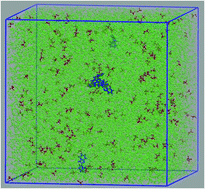Aggregation induced enhanced emission of 2-(2′-hydroxyphenyl)benzimidazole
Abstract
In this study, the aggregation induced emission enhancement (AIEE) of 2-(2′-hydroxyphenyl)benzimidazole (HPBI) is reported. To investigate the AIEE process of HPBI, absorption/fluorescence spectroscopy, fluorescence imaging and field emission scanning electron microscopy were employed. A comparative study with 2-phenylbenzimidazole (PBI) divulges the significance of the hydroxyl group in the AIEE process. Further, molecular dynamics simulations have been carried out with explicit solvent molecules to follow the aggregation process of HPBI with time. The obtained molecular dynamics simulation results not only predicted the formation of aggregates but also provided detailed insight and information on the molecular interactions. The cellular studies showed aggregates yield higher fluorescence in the visible region inside HeLa cells in comparison to monomeric compounds which failed to exhibit any visible fluorescence inside the cell. The obtained aggregates were further found to be biocompatible and therefore can be used for bio-imaging applications.


 Please wait while we load your content...
Please wait while we load your content...